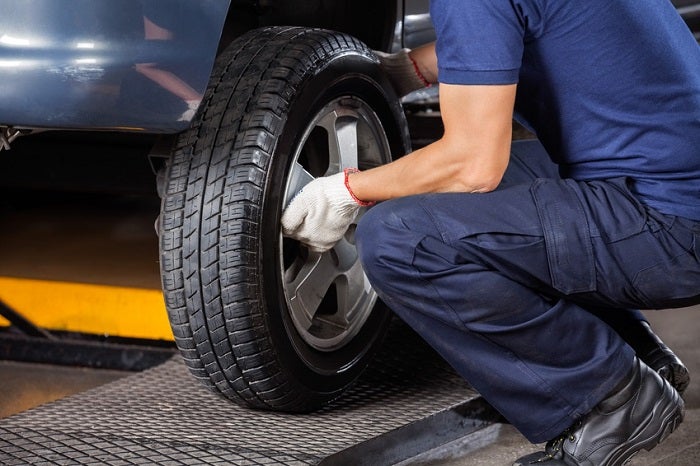Experience Accuracy with GMC Tire Service at Morris Tires
Experience Accuracy with GMC Tire Service at Morris Tires
Blog Article
Tire Solution: The Influence of Weather
When it pertains to guaranteeing ideal efficiency and safety and security on the road, understanding the effect of weather on tire solution is critical. From scorching warm to icy roads, each weather aspect can dramatically affect tire capability and total driving experience. By diving into the results of varying climate conditions on tires, chauffeurs can get useful insights that might improve their lorry's efficiency and long life. In this conversation, we will certainly check out the elaborate relationship between climate problems and tire service, dropping light on the importance of weather-specific tire maintenance techniques and considerations.
Heat and Tire Performance
When revealed to high temperature levels, tires experience adjustments in performance that can significantly affect automobile security and handling. The heat generated from extended driving or heat conditions causes the tire rubber to soften, causing lowered walk life and increased wear. As the rubber comes to be softer, the tire's hold when driving diminishes, affecting stopping distances and total traction. In extreme situations, extreme warmth can even trigger tire blowouts, posing an extreme security risk to the vehicle and its occupants.

Cold Weather Condition Impacts
Winter conditions can have a substantial influence on tire efficiency and safety and security. As temperatures drop, tire rubber can solidify, resulting in lowered traction on icy or snow-covered roads. In winter, tires may likewise lose atmospheric pressure more rapidly, which can affect handling and gas effectiveness. In addition, chilly temperatures can trigger tire sidewalls to tense, raising the risk of damages from craters or various other roadway dangers.
To minimize the impacts of winter on tires, it is crucial to on a regular basis inspect tire pressure and inflate them to the manufacturer's suggested levels. Utilizing wintertime or all-season tires developed for winter problems can likewise improve grip and grasp on icy or snowy roads. Appropriate tire upkeep, consisting of regular assessments for wear and damages, becomes much more vital throughout colder months to make sure optimal performance and security.
Rainy Issues Effect
Throughout rainy problems, tire efficiency and safety can be considerably influenced by the damp road surfaces and decreased exposure. The step pattern of tires plays a crucial role in preserving traction on wet roads. Tires with worn-out treads are a lot more prone to hydroplaning, where a layer of water constructs up between the tire and the roadway surface, causing loss of grip. To combat this, vehicle drivers should consistently examine their tires for redirected here adequate step depth and think about investing in tires specifically developed for wet conditions.
Additionally, rainy weather condition can likewise lower visibility, making it testing for drivers to see the road in advance clearly (GMC Tire Service). In such conditions, it is necessary to change driving speeds appropriately and keep a safe adhering to range to permit sudden quits. Properly filled with air tires can also help in preserving control on wet roads by providing much better handling and grip
Snow and Tire Safety And Security
Snow-covered roadways position distinct challenges for vehicle drivers, stressing the importance of correct tire selection and upkeep. When driving in snowy problems, having the ideal tires can make a significant difference in safety and security and performance. Winter months tires are designed with special rubber substances and step patterns to provide much better traction on snow and ice compared to all-season tires. The much deeper footsteps and sipes of winter season tires aid hold the road much better, decreasing the threat of sliding and slipping.

It is vital to adhere to supplier directions when using and mounting tire chains to stop damage to the tires and car. By picking the ideal tires, maintaining proper rising cost of living, and taking into consideration added traction aids like tire chains, drivers can improve their safety and security when browsing snow-covered roads.
Weather-Related Tire Maintenance
When encountered with numerous weather condition conditions, proper tire upkeep becomes a critical aspect of automobile safety and security and performance. Weather-related tire upkeep incorporates a variety of practices focused on making certain optimal tire function and long life in various weather condition situations. One crucial facet of weather-related tire maintenance is tire pressure policy. Fluctuating temperature levels can cause tire pressure to vary, influencing traction and gas efficiency. Routinely inspecting and changing tire pressure according to supplier suggestions is crucial for risk-free driving in altering weather problems. In addition, tire tread depth plays a considerable role in taking care of various weather condition elements. Tires with sufficient tread deepness give better hold on wet or icy roads, reducing the risk of hydroplaning or skidding. Examining tire tread on a regular basis and replacing tires when tread wear reaches a certain depth is vital for preserving traction and security in adverse weather condition. By prioritizing weather-related tire upkeep, chauffeurs can boost safety, enhance car efficiency, and lengthen the life expectancy of their tires.
Verdict
In verdict, weather condition problems have a significant influence on tire efficiency and safety. From heat influencing tire pressure and wear to cool climate lowering traction, it is essential to take into consideration the climate when keeping and utilizing tires.
In this conversation, we will certainly discover the intricate connection in between climate problems and tire solution, losing light on the value of weather-specific tire upkeep practices and factors to consider.

Report this page